What are we really going to get for these I-35 caps?
Terrifying cost, unconvincing design.

A few weeks ago we stopped in Dallas on our way back from visiting family in Oklahoma. There was only one thing I had to see: Klyde Warren Park.
Klyde Warren is the 5.2 acre public space built on top of the Woodall Rodgers Freeway in downtown Dallas. It's held up as a model for mitigating the unpleasantness of urban highways, especially by those in Austin who are pushing for the city to build caps on the soon-to-be-expanded I-35.
KWP is certainly a nice space. On that brisk December morning there were dozens of children on the playground, and it was not hard to imagine that the line of tables and chairs on the wooden walkway, combined with the food trucks parked nearby, would make the park an attractive lunch spot for downtown office workers.
There is reason to believe, however, that what we'll get in Austin will come at a much greater cost but not be nearly as nice.
It's all about the frontage roads
One of the reasons Klyde Warren probably works as a public space is the frontage roads. They're not normal frontage roads. The speed limit is 30 mph. There are only two traffic lanes. There is street parking on one side of the road and bulb outs and food trucks on the other side.
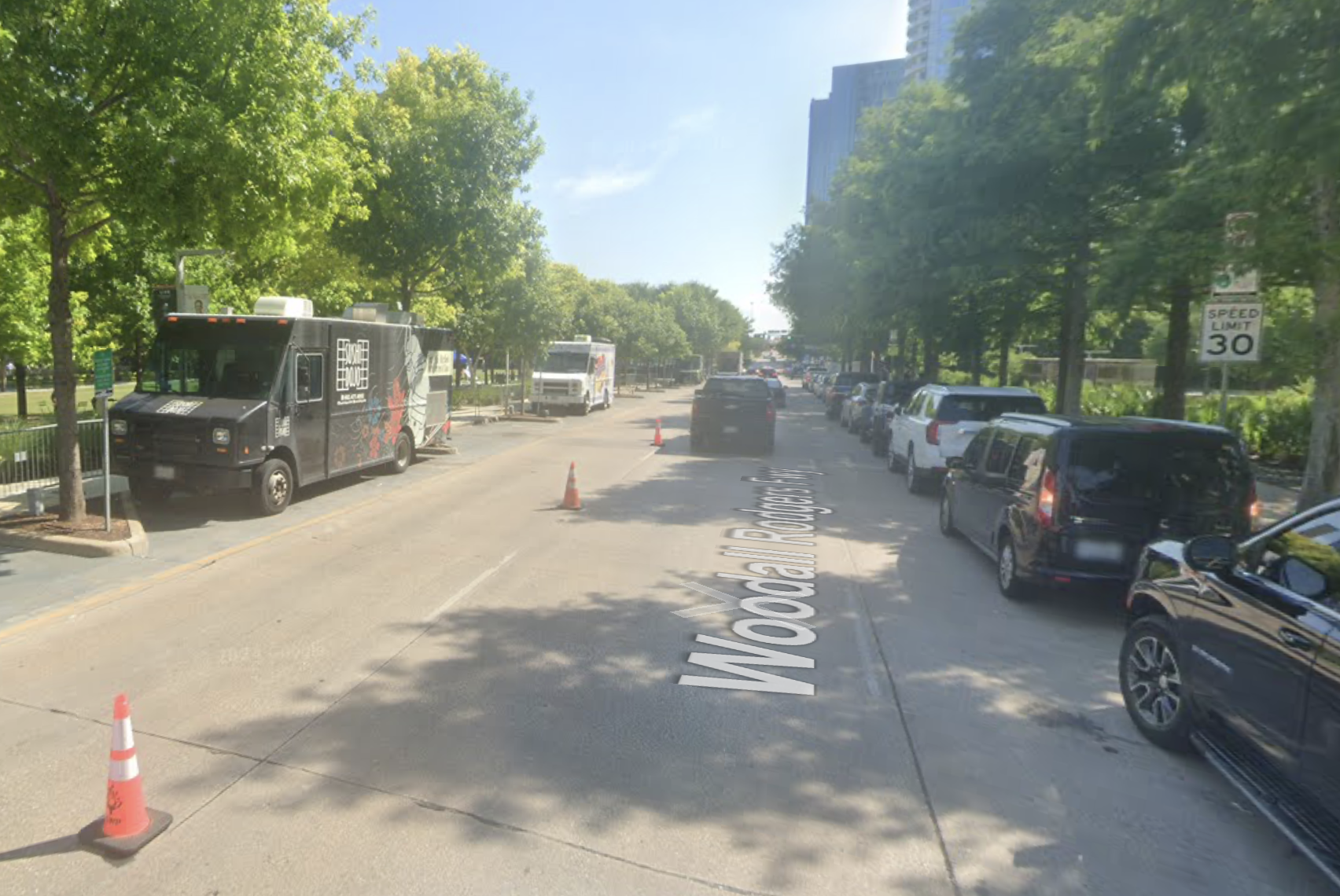
In other words, unlike a typical frontage road, which is usually nothing more than a slightly slower highway next to a highway, this is a slow-moving street that is easy and safe to cross.
Unfortunately, this isn't what's planned for I-35's frontage roads. There are strong indications that they'll be just as shitty as what currently exists. In some cases they may be even shittier.
TxDOT has said it will be pursuing a "boulevard" concept for the frontage roads between Cesar Chavez & 12th St, but it doesn't look like much in the design will actually create a boulevard experience. A boulevard implies a vibrant city street where people comfortably bustle outside of automobiles.
If we take TxDOT at its word, the roads will still be faster than in Dallas. Agency spokesman Brad Wheelis tells me that the posted speed limit will be 30 mph downtown but 40 mph north of Airport Blvd or south of Oltorf. When I asked what the design speed of the road will be, Wheelis said it will be the same as the posted speed limit.
However, when I reached out to the city Transportation & Public Works Dept, I was told, "TxDOT and the City of Austin have worked together to lower design speeds of the frontage roads to between 35 and 40 mph with posted speed limits to be determined."
There's a big difference between 30 mph and 40 mph when it comes to pedestrian safety –– or driver safety, for that matter. Every 10 mph increase in speed doubles the chance of pedestrian death.
I asked if the boulevard concept means there will be street parking, like in Dallas.
"Parking is not part of the design of the boulevard segments," said Wheelis.
So how do TxDOT and the city of Austin justify describing these new frontage roads as a "boulevard"? That apparently hinges on the fact that they're putting the northbound and southbound frontage roads on the same side of the highway.
So in this rendering of an imagined cap between 4th & 7th Streets, there are not four lanes to cross on both sides, but eight lanes to cross on the west side.
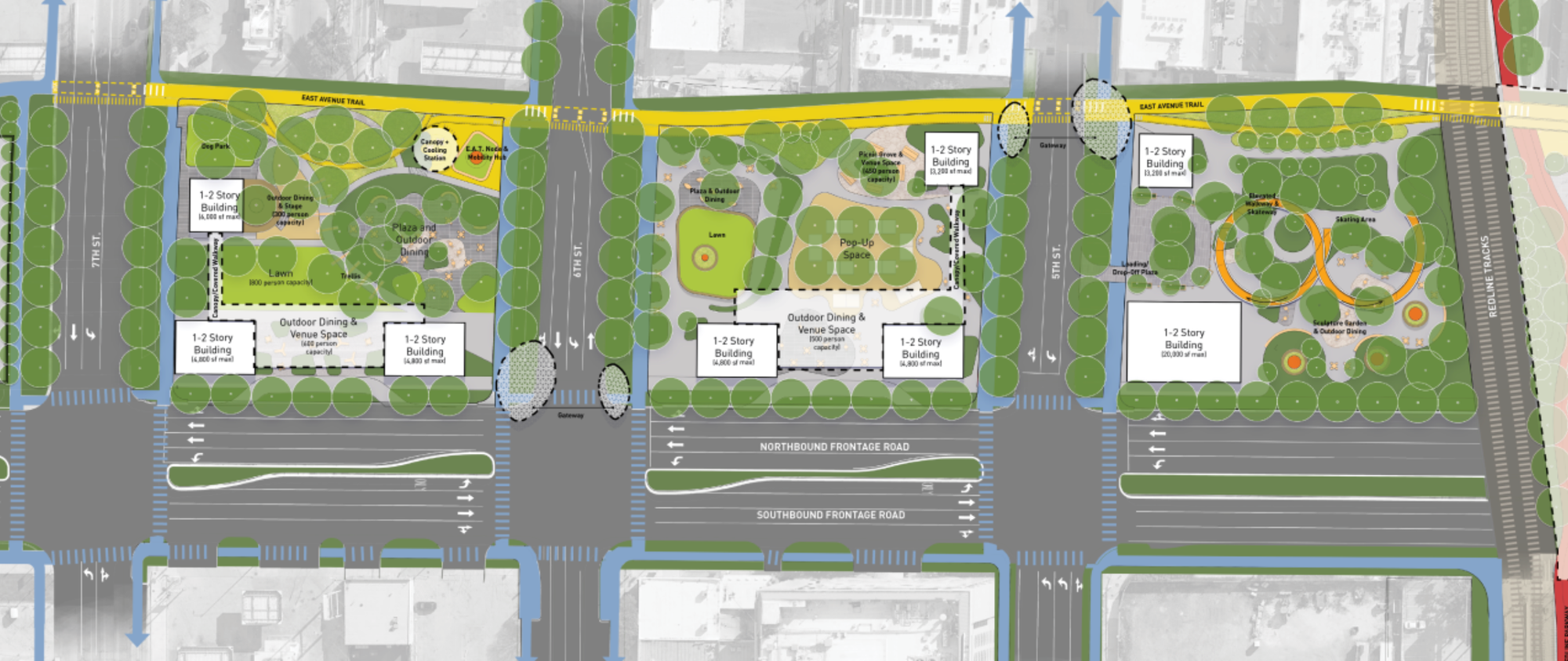
That's great if you're coming from the east. Not so great if you're coming from the west. Granted, the city points out that if you're coming to the cap on 3rd or 4th St, you won't have to cross the street at all, since it will dip under the Red Line pedestrian path.
The cap proposed at 11th & 12th Street appears even harder to get to from the west.
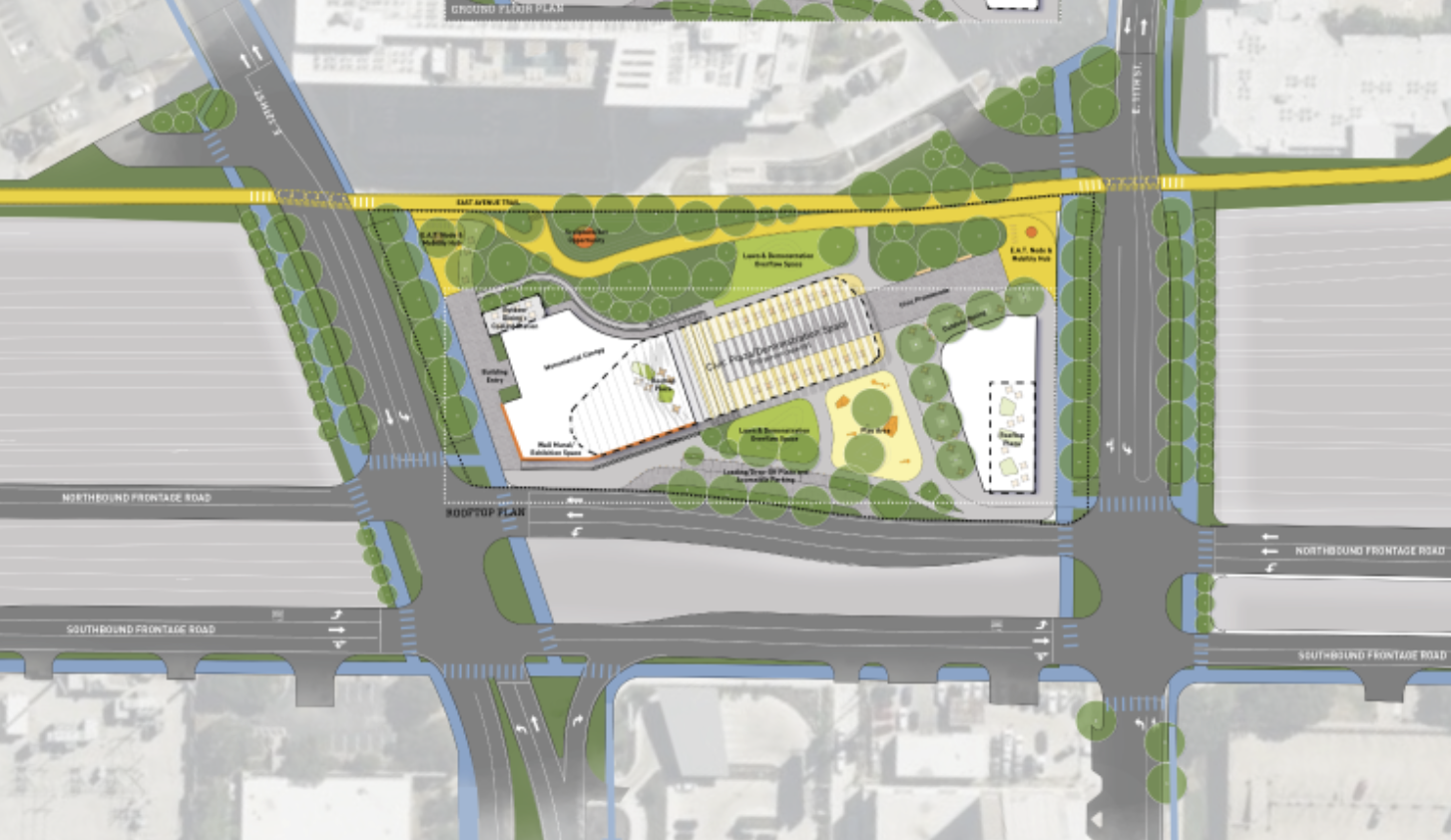
Even the rendering that is supposed to make this look as nice as possible shows a shitload of roadway and cars surrounding what is pitched as a respite from the concrete jungle.
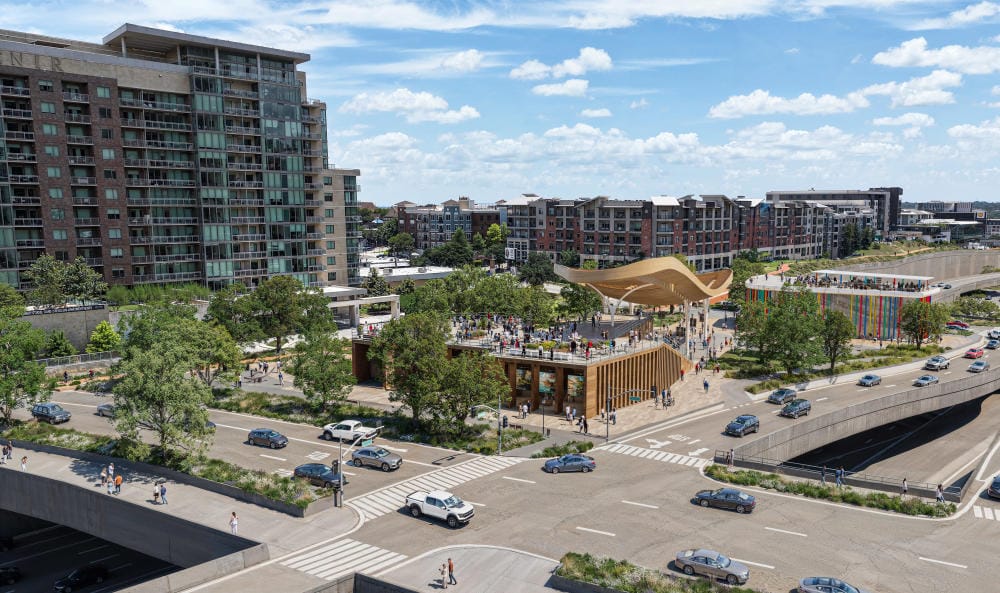
The "boulevard concept" will not be in play for the proposed northern cap, between 38 1/2 St to 41st St, which will have frontage roads on both sides.
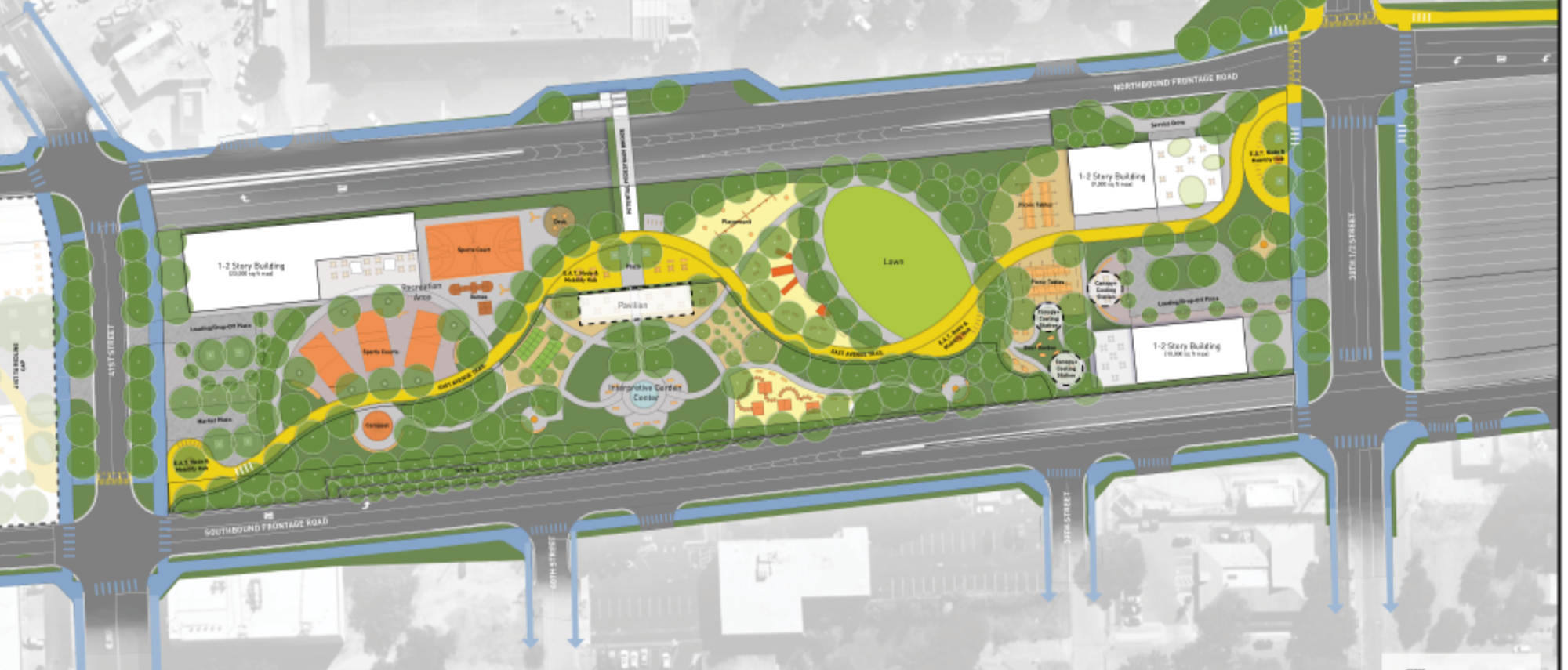
The city transportation department acknowledges that pedestrian crossings here will be a challenge. Here's what they told me:
Between these signalized intersections with pedestrian crossings, the frontage roads tend to dip below grade as on-ramps and off-ramps connect to the highway travel lanes that are tunneled under the caps, making at-grade crossings of the frontage roads between intersections challenging. These segments between signalized intersections where frontage road grades vary will be protected by treatments including fencings, art walls, raised seating and landscape berms, similar to the treatments at Klyde Warren Park.
There will only be crossings every 1,000 to 1,750 ft, but "future amenity design plans for these caps should evaluate opportunities for elevated mid-block pedestrian bridges where feasible, which would likely require coordination with private property owners."
Brendan Wittstruck, an urban design architect who lives in Hyde Park and is active in the North Central I-35 Neighborhood Coalition, told me this about the proposed frontage road design:
Fast-moving frontage roads, including the "boulevard" concept downtown, create massive physical and mental barriers that run the risk of disincentivizing people to ever go to the caps, regardless of their programming. Klyde Warren, for its part, succeeds not because of the design of the park itself but because of the design of its edges and connections.
Precious capital
Even if I had more confidence in these caps succeeding, I would be skeptical that they're a worthy use of precious public dollars and, just as importantly, precious political capital.
The total estimated cost of doing all of the proposed caps and stitches has ballooned to $1.4 billion, at least according to TxDOT.
And then there's the estimated annual maintenance cost of $47 million.
City staff has suggested ditching parts of the plan to reduce the cost. In November they recommended a scaled back plan that they project would only cost about $400M after taking into account the $150 million in federal grants, which are supposed to fund the cap between Cesar Chavez & 4th St.
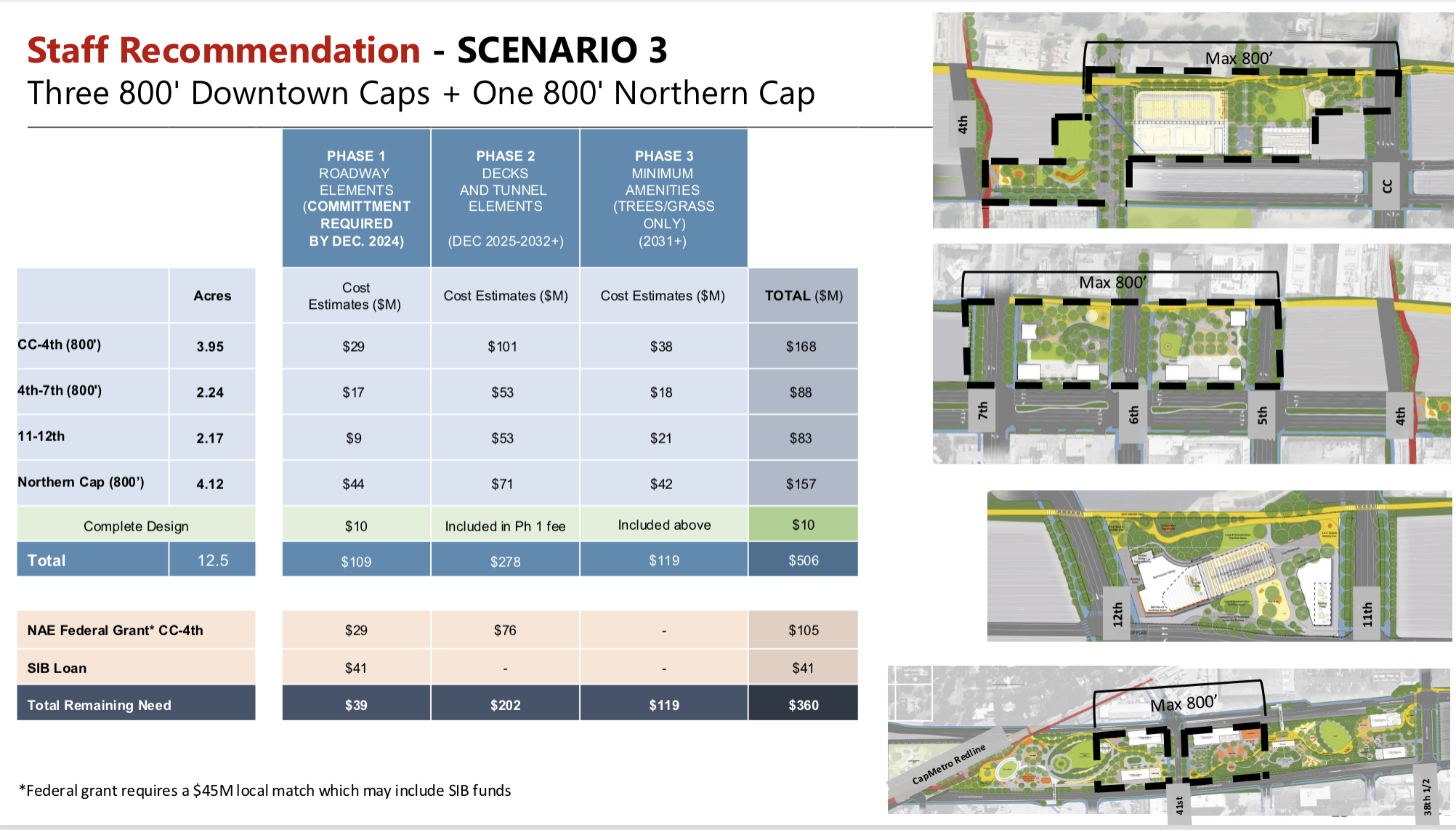
That's still a ton of money with a very dubious ROI. In March, City Council will have to decide whether to commit to pay up to $265 million for "roadway elements" that will allow the caps to be installed. Grants will cover some of that, but the city will have to ask voters to approve bonds to fund the rest. And then it will have to go back a couple years later and ask for the rest of the money to actually build the caps.
In the decade I've lived here, I've supported every bond and spending measure the city has put on the ballot. And I've generally argued that, in the recent political landscape, the liberal November electorate would approve just about anything. And they have!
But even a liberals will eventually revolt if they no longer believe they're getting something in return for their sacrifice.
And frankly, the conditions are ripe for that type of cynicism to take hold.
Consider that the city is still struggling –– and in some cases simply failing –– to deliver the $420 million of improvements to our major streets that voters approved eight years ago. In the very best case scenario, at some point in the next decade we'll get less than half of the rail that we approved in 2020. And, although this is not the city's fault but the state and school district's fault, voters just approved a significant school tax increase but only 25% of it will actually go to local schools! We're just getting out of a period of high inflation and we just elected a president who, despite owing his victory largely due to cost of living frustrations, is aggressively pursuing trade and immigration policies that are expected to raise prices. So we might also see interest rates rise again.
And keep in mind that in the next few years –– probably 2026 or 2028 –– City Council is going to be forced to ask voters to approve a tax hike just to keep basic services afloat. If they lose that vote, we're seriously fucked.
All of this is reason for local leaders to proceed with caution when asking voters for more money. If we're going to ask for sums this large, we should deliver products that voters can identify, appreciate and feel are dispersed fairly.
If we're going to spend $400 million on public spaces, I think urban trails and neighborhood parks are a better bet on every metric: environment, health, happiness, civic trust, etc.
Yes, sometimes you need a big investment in something that not everyone is going to directly benefit from. If we ever do get a rail line, it should go on Guad/Lamar/S. Congress because that's where the most people are. And anybody who says otherwise doesn't know what they're talking about. And it makes sense that we put some of our best stuff –– the Central Library comes to mind –– downtown. It belongs to everyone. The city should support it as a destination and gathering point.
There's also the argument that these investments will be repaid by spurring new development nearby –– new development allows the city to collect more tax revenue than would otherwise be allowed by state law. But again, this claim depends on the caps adding significant value to an already very valuable part of town. Alas, I'm unconvinced.
There is a way to generate a ton of tax revenue from the highway corridor, but it would involve either actually replacing the whole highway with a boulevard or putting the entire highway underground and then putting a legit urban boulevard on top. Unfortunately neither of those options are on the table because TxDOT is only interested in doing what it knows, which is building big, bloody highways. (It's worth noting that securing funding for this monstrosity was one of the highlights of Kirk Watson's career in the Texas Senate)
The Central Library, which cost $126 million, has been a tremendous success and a source of pride for Austin. How much confidence do we have that these caps, which will cost at least triple that (and probably much more), will be similarly successful? And how much confidence do we have that this is a better use of funds than, say, building recreational spaces and infrastructure all over the city?
If somebody forwarded you this email, please consider subscribing to the newsletter by visiting the website.





